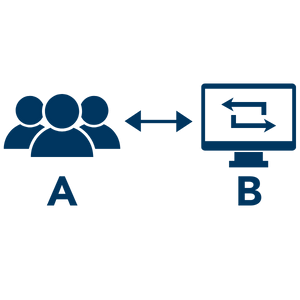Organizing a course is a circular process of organizing content, defining learning outcomes, outlining assessments, and deciding on how to facilitate interactions between class members. As you engage in this circular process, you will also need to consider how the course format (in-person, blended, flipped, hybrid, or online) and educational technologies might best support student learning. Carefully structuring your course to take advantage of the best pedagogical strategies and appropriate technologies for your content and teaching style can greatly benefit your students.
Defining Course Formats at UCSB
In-person courses range from traditional in-person lectures to highly blended, flipped and hybrid courses. Blended and flipped courses typically meet in person for every class period. Hybrid courses (as defined by UCSB) meet in-person for less than 50% of their scheduled weekly meeting hours and heavily integrate online materials, communication, interactions, and activities to support learning. Online courses have no in-person meetings, and distribute all necessary course material, communications, activities, and assessments online. Online courses can be asynchronous or synchronous, or some blend of the two. Hybrid and online courses are subject to supplemental Senate approval.
In-person Course Formats
In-person
Instructors and students are physically present in the same space for lecture or section at preset times/days. Some instructional materials, communication, and/or assessments are distributed or collected digitally, usually through a course website.

Blended
In-person classes that provide many instructional materials, communications, learning/group activities, and/or assessments digitally, usually through a course website.

Flipped
In-person classes that put much of the explanatory lecture and course material online for students to complete before in-person class time. Instructors use active learning activities during class to deepen students’ practice with the content. Some in-person class time could be replaced with online asynchronous work (up to 49%) without UCSB considering the course as Hybrid. The video below gives more details about how to flip a course (or just flip a few classes).
Online Course Formats
The short videos below on Preparing to Teach Online and Weekly Patterns for Online Courses are brief overviews of how to approach online or hybrid course design as an iterative and creative process that accounts for the inherent flexibility in time, space, and technology of online teaching and learning.
The online and hybrid courses listed below are subject to supplemental Senate approval criteria. Please contact Instructional Development for information and guidance at least one year prior to your proposed course start date, or as soon as possible if less than one year (see timeline section below).
Hybrid
50% or more of the preset in-person instructional times are replaced by digital instruction and activities, such as readings, pre-recorded video lectures, internet resources, online assessments, video conferences, group work or discussions. Hybrid courses often use a flipped classroom format for in-person meetings.

Dual-Mode / HyFlex
An in-person class that simultaneously live streams the course so students can choose to attend virtually or in-person (they can choose their attendance mode each class period, or choose for the duration of the term). These courses often use additional cloud technologies (like online polls, backchannel chats, and/or collaborative documents) to engage and interact with both student audiences simultaneously. They also keep all of their materials and assessments online to accommodate student needs and streamline the student experience between the two audiences. Importantly, dual-mode courses require careful course design, flexible teaching and technical skills, and additional technological and personnel resources.

Purely asynchronous online course
Based on providing the maximum flexibility for students and instructors. Most/all of the work is done independently on a flexible schedule using asynchronous activities and interactions.

Synchronous online course
Based on maximizing synchronous interactions between class members using a variety of digital communication tools. All students follow the same assessment and activities schedule.

Timeline and Process for Developing an Online or Hybrid Course at UCSB
UCSB departments and/or individual faculty members may propose to develop online or hybrid courses for any quarter without funding. However, we strongly suggest applying for funding to design and develop a hybrid or online course to better ensure high quality digital materials or to hire student assistants or staff to help with development.
Instructors are strongly encouraged to work directly with the Instructional Consultants at oic@id.ucsb.edu for guidance and assistance in applying for a grant, and for all subsequent approval and/or development processes. These include:
-
Determining and applying for the most appropriate grant funding source.
-
Discussing the course proposal and relevant funding requirements with your department chair and/or curriculum committee.
-
Applying for the grant.
-
After a grant is funded, the instructor must apply for Master Course Approval for Online and Hybrid Courses, which requires supplemental materials (in the form of 3 pages of narrative response to questions, a syllabus, and relevant appendices) to be submitted to your college Faculty Executive Committee and then to the Senate Committee on Courses and General Education for approval. The approval process takes approximately 3-6 months. A course must be approved by the Faculty Executive Committee and the Senate Committee on Courses and General Education before the it can be listed in the registrar's schedule of classes.
-
Developing the online course with guidance and support from relevant campus entities, such as Instructional Consultants, Video Services and Canvas. You can develop the course while awaiting Master Course Approval.
-
Proofing, piloting, reviewing and launching the course.
-
Gathering evaluative evidence for course review and subsequent revisions.
-
After 2 years, requesting permanent status as an online or hybrid course by reporting back to the Senate committees on the successes, challenges and opportunities of the online course for students and instructors.
Instructional Development is positioned to help with every aspect of this process. Contact us at oic@id.ucsb.edu to talk through your course ideas.